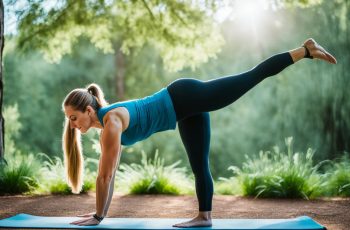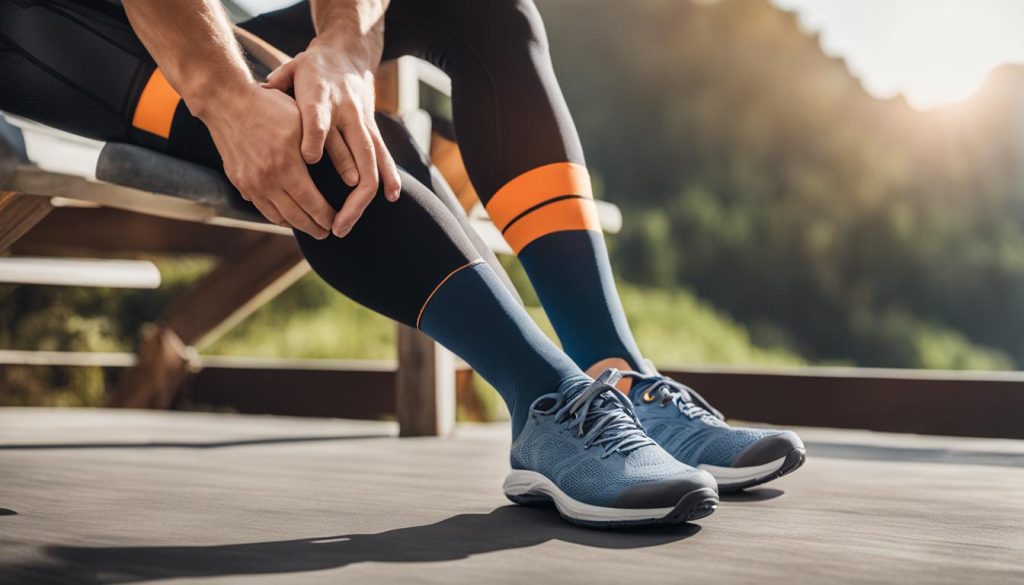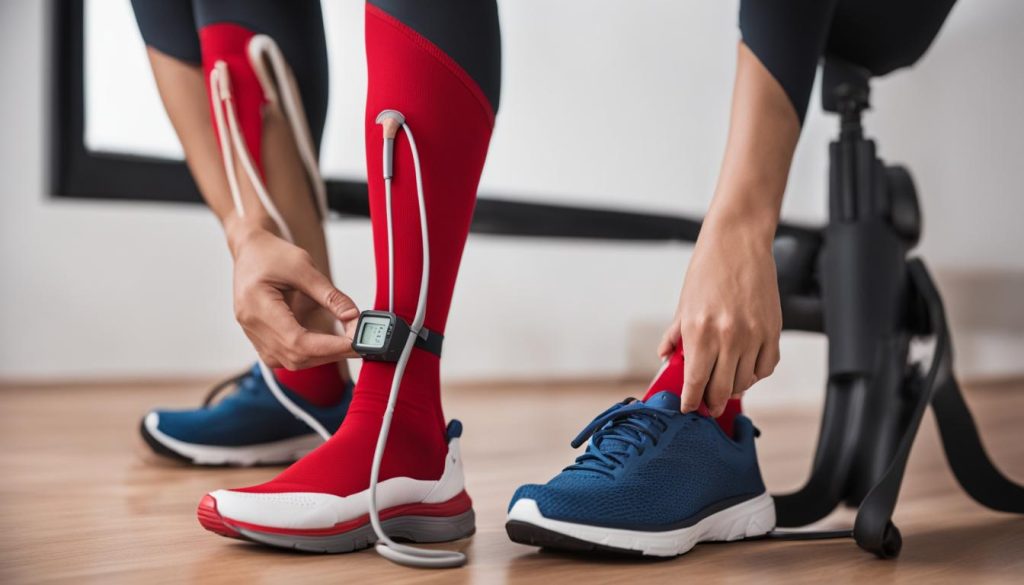Are you experiencing discomfort due to poor circulation in your feet? Don’t worry, I’ve got some helpful tips to improve blood flow and enhance circulation to your lower extremities. Poor circulation can make it challenging to go about your daily activities, but with a few simple lifestyle changes, you can optimize blood circulation to your feet and toes.
There are various factors that can contribute to poor circulation in the feet, including excess plaque, blood clotting, and constricted blood vessels. But fret not, there are natural methods to stimulate blood circulation and increase blood supply to your lower limbs. Let’s dive into some effective strategies to improve blood flow to your feet naturally.
Improve Blood Flow to Your Feet
- Regular exercise is essential for improving circulation in the feet.
- Wearing compression socks can significantly boost blood flow to your lower extremities.
- Massaging foot tissue can improve blood circulation and provide relaxation.
- A healthy diet, rich in vegetables and fruits, promotes better blood flow to your feet.
- Elevating your legs can help enhance circulation and promote healing.
Get Proper Exercise
Regular exercise is essential for improving circulation in the feet. Even a small amount of daily exercise can make a difference. Try engaging in mild aerobic exercise for 15 minutes every day. Exercise not only helps boost blood flow to your feet but also promotes overall health and prevents cardiovascular disease, cancers, and obesity.
There are several effective blood circulation exercises for feet that you can incorporate into your daily routine:
- Ankle Rotations: Sit comfortably and lift one foot off the ground. Rotate your ankle clockwise for 10 seconds, then counter-clockwise for another 10 seconds. Repeat with the other foot.
- Toes Stretch: Sit on a chair and extend your legs in front of you. Lift your toes up as high as possible, hold for a few seconds, and then lower them down. Repeat this exercise 10 times for each foot.
- Heel Lifts: Stand with your feet hip-width apart. Slowly raise your heels off the ground and stand on your toes for a few seconds. Lower your heels back down to the ground. Repeat this exercise 10 to 15 times.
- Foot Flexes: Sit on a chair and place a towel on the floor in front of you. Use your toes to scrunch and gather the towel towards you, then release it back to its original position. Repeat this exercise 10 times with each foot.
Remember to start slowly and gradually increase the duration and intensity of your exercises over time. It’s important to listen to your body and not exert yourself too much, especially if you have any pre-existing conditions or injuries.
By incorporating these exercises into your daily routine, you can actively contribute to better vascular health and improve blood circulation in your feet.
Use Compression Socks
Compression socks are a great way to boost blood flow to your feet and improve circulation in your lower extremities. These specialized socks are designed to provide gentle pressure to the legs and feet, helping to prevent conditions like deep venous thrombosis and reducing pain and swelling.
Athletes often use compression socks to enhance their performance and recovery, but they offer benefits to everyone. Whether you spend long hours standing or sitting, wearing compression socks during the day can help optimize blood circulation to your feet and toes.
Compression socks work by applying graduated compression, meaning that they exert the most pressure at the ankle and gradually decrease pressure as they move up the leg. This helps to improve blood flow and prevent blood from pooling in the lower limbs.
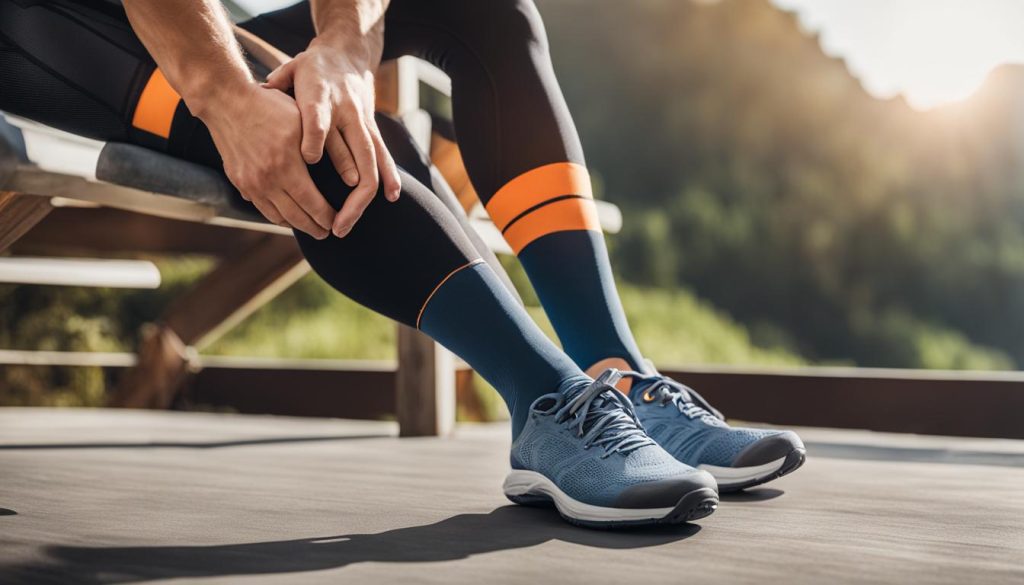
When choosing compression socks, make sure to select the right size and compression level for your needs. Higher compression levels provide more pressure and are often recommended for individuals with more severe circulation issues.
By wearing compression socks regularly, you can stimulate blood circulation in your feet and increase the blood supply to your lower limbs. It is recommended to wear them during the day, especially if you are on your feet for extended periods or have a sedentary lifestyle.
Remember that compression socks are not a substitute for other circulation-boosting activities such as exercise, a healthy diet, and elevating your legs. They are a valuable tool in your journey toward better foot circulation and overall vascular health.
Massage Foot Tissue
When it comes to finding natural remedies for proper foot circulation, regular foot massages are a simple yet effective solution. By gently massaging your feet nightly, you can prevent poor circulation, improve blood flow, and promote overall foot health.
Foot massages provide several benefits, including preventing plaque buildup that can obstruct blood vessels. Plaque can restrict blood flow and lead to poor circulation in the feet. By using your fingers or a massaging tool to apply gentle pressure and knead the muscles, you can break down any existing plaque and stimulate blood circulation.
Regular foot massages are not only beneficial for your circulation but also provide relaxation and stress relief. As you massage your feet, you can release tension and promote a sense of well-being. It’s a fantastic opportunity to unwind after a long day and prioritize your self-care.
Consider Using a Massaging Tool
If you prefer a more convenient option for foot massages, consider incorporating a massaging tool into your routine. There are various tools available in the market, such as handheld massagers or foot spas, that can help you achieve the desired results with ease. Explore different options and find the tool that suits your preferences and needs.
Remember, consistency is key when it comes to improving blood flow in your feet. Aim to massage your feet nightly or at least a few times a week to experience the full benefits.
Eat a Healthy Diet
Adopting a healthy diet is crucial for improving blood flow to your feet. By making smart food choices, you can naturally enhance circulation and promote overall vascular health. Start by avoiding artificial ingredients and excess sugars, as they can have a negative impact on your circulation.
To optimize blood flow to your feet, include a variety of vegetables and fruits in your daily meals. These nutrient-rich foods provide essential vitamins and antioxidants that support cardiovascular health and reduce inflammation. Additionally, foods rich in vitamin B, such as whole grains, legumes, and leafy greens, can further promote blood vessel function and help enhance circulation.
By fueling your body with a wholesome, well-rounded diet, you are giving your feet the nutrients they need to thrive. Remember to stay hydrated throughout the day as well, as proper hydration is important for maintaining healthy blood flow.
Here are some beneficial food choices to improve blood flow to your feet:
- Dark leafy greens, such as spinach and kale
- Citrus fruits like oranges and grapefruits
- Colorful berries, such as blueberries and strawberries
- Whole grains, including oats and quinoa
- Legumes like beans and lentils
- Fatty fish, such as salmon and mackerel, rich in omega-3 fatty acids
By incorporating these foods into your diet, you can support healthy blood flow and improve the overall well-being of your feet. Remember, a balanced and nutritious diet coupled with other lifestyle changes can make a significant difference in optimizing blood circulation to your feet.
Keep Legs Elevated
Elevating the legs above heart level is one of the best tips for better foot circulation. By elevating your legs, you allow gravity to assist in improving blood flow to your feet. After a long day, find a comfortable spot where you can lean back and elevate your legs on an ottoman or pillow. This position helps reduce swelling, alleviate discomfort, and enhance circulation.
Combined with a gentle foot massage, elevating your legs can promote healing and further enhance circulation. As you relax, gently massage your feet to stimulate blood flow and relieve tension. This simple practice can be done in the comfort of your own home and is a great way to care for your feet.
Try to make it a habit to keep your legs elevated for at least 30 minutes every night. You can do this while watching TV, reading a book, or simply unwinding after a busy day. Not only will it benefit your foot circulation, but it will also provide a time of relaxation and rejuvenation for your entire body.
By incorporating the practice of elevating your legs into your daily routine, you can improve blood flow to your feet and promote better foot circulation naturally.
Monitor Your Blood Pressure
Monitoring your blood pressure is crucial for maintaining good circulation. High blood pressure can negatively impact circulation and lead to various health issues.
To promote better blood flow to your feet and boost blood flow to your lower extremities, it is essential to keep your blood pressure in check. Aim to keep your blood pressure below 120/80, which is considered a healthy range. Regularly monitoring your blood pressure can help you identify any fluctuations or potential problems early on.
If you have concerns or a history of high blood pressure, it is important to consult a healthcare professional. They can provide valuable guidance and recommend appropriate measures to optimize your blood circulation to your feet and overall vascular health.
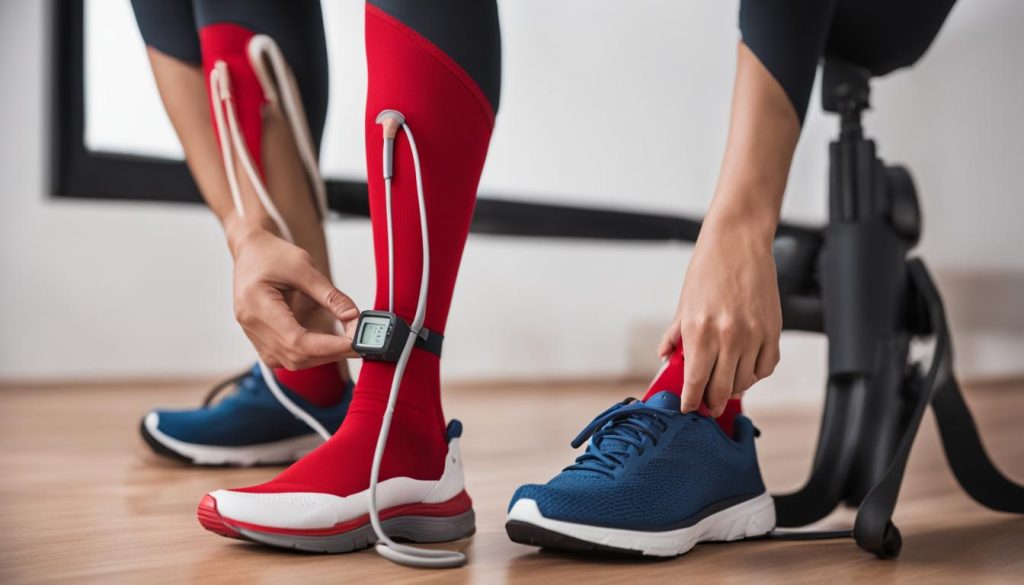
By actively monitoring your blood pressure and seeking professional advice when needed, you can take proactive steps towards promoting better blood flow to your feet and enhancing circulation in your lower extremities.
Conclusion
Enhancing blood circulation in your feet is vital for optimal health and well-being. By incorporating these tips into your daily routine, you can optimize blood flow to your feet and improve overall vascular health.
Regular exercise plays a crucial role in boosting blood circulation to the lower extremities. Engage in mild aerobic activities for just 15 minutes each day to promote better circulation. Remember, even small amounts of exercise can make a significant difference.
Wearing compression socks is another effective way to enhance blood flow to your feet. These specialized socks help prevent deep venous thrombosis and reduce pain and swelling. Consider wearing them during the day for maximum benefits.
Additionally, massaging your foot tissue can stimulate blood circulation and prevent plaque buildup. Use a massaging tool or gently massage your feet nightly for a soothing experience that promotes improved circulation.
A healthy diet rich in vegetables, fruits, and vitamin B can also contribute to better blood flow to your feet. Avoid artificial ingredients and excessive sugars, as they can negatively affect circulation.
Keeping your legs elevated above heart level for 30 minutes each night can further enhance blood circulation. Combine this with a gentle foot massage to promote healing and relaxation.
Monitoring your blood pressure is essential in maintaining good circulation. Ensure your blood pressure remains below 120/80 and consult a healthcare professional if you have any concerns or a history of high blood pressure.
By following these tips, you can naturally enhance blood circulation in your feet and optimize blood flow. Remember to prioritize a healthy lifestyle and take care of your well-being for long-term vascular health.
FAQ
What are some ways to improve circulation in the feet?
There are several ways to improve circulation in the feet. These include exercise, wearing compression socks, massaging foot tissue, eating a healthy diet, keeping legs elevated, monitoring blood pressure, and managing stress.
How does exercise help improve circulation in the feet?
Exercise is essential for improving circulation in the feet. Even a small amount of daily exercise can make a difference. Engaging in mild aerobic exercise for 15 minutes every day promotes overall health and prevents cardiovascular disease, cancers, and obesity.
How can compression socks help with improving circulation in the feet?
Compression socks are beneficial for improving circulation in the feet. They help prevent deep venous thrombosis and reduce pain and swelling. Athletes commonly use compression socks, but they are beneficial for everyone. Wear compression socks during the day for optimal results.
How does massaging the feet help improve circulation?
Massaging the feet nightly can help prevent poor circulation. Gentle foot massages can prevent plaque buildup and improve blood flow. Regular foot massages can also provide relaxation and stress relief. Consider using a massaging tool for convenience.
What role does a healthy diet play in improving blood flow to the feet?
Adopting a healthy diet is crucial for improving blood flow to the feet. Avoiding artificial ingredients and excess sugars, as they can negatively impact circulation. Including vegetables, fruits, and foods rich in vitamin B in your diet can reduce inflammation and promote blood vessel function.
How does keeping the legs elevated help with foot circulation?
Elevating the legs above heart level can help improve circulation. After a long day, you can lean back and elevate your legs on an ottoman or pillow. This position, combined with a gentle foot massage, can enhance circulation and promote healing.
Why is monitoring blood pressure important for foot circulation?
Monitoring your blood pressure is crucial for maintaining good circulation. High blood pressure can negatively impact circulation and lead to various health issues. Keeping your blood pressure below 120/80 and consulting a healthcare professional if you have concerns or a history of high blood pressure is essential.
How can I enhance blood circulation in my feet?
By following the tips provided, such as exercising regularly, wearing compression socks, massaging foot tissue, eating a healthy diet, keeping legs elevated, monitoring blood pressure, and managing stress, you can enhance circulation in your feet naturally and promote vascular health. Remember to maintain a healthy lifestyle and prioritize your well-being.




